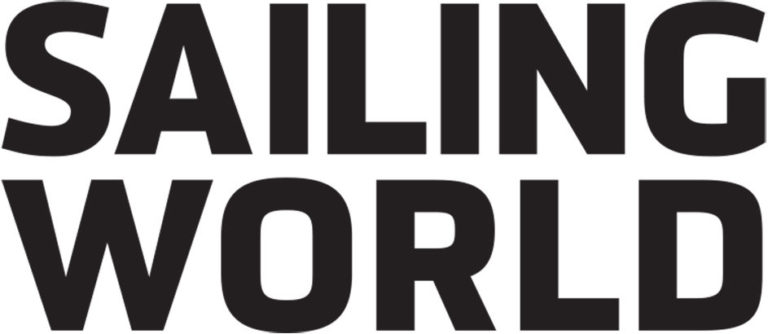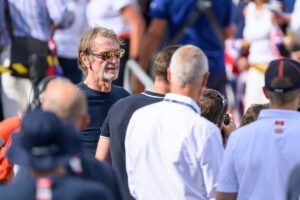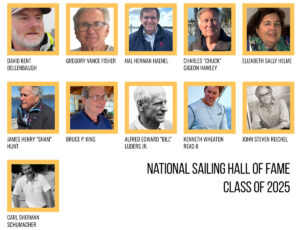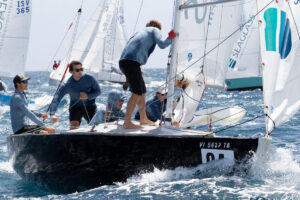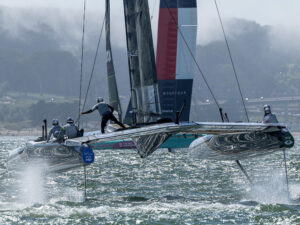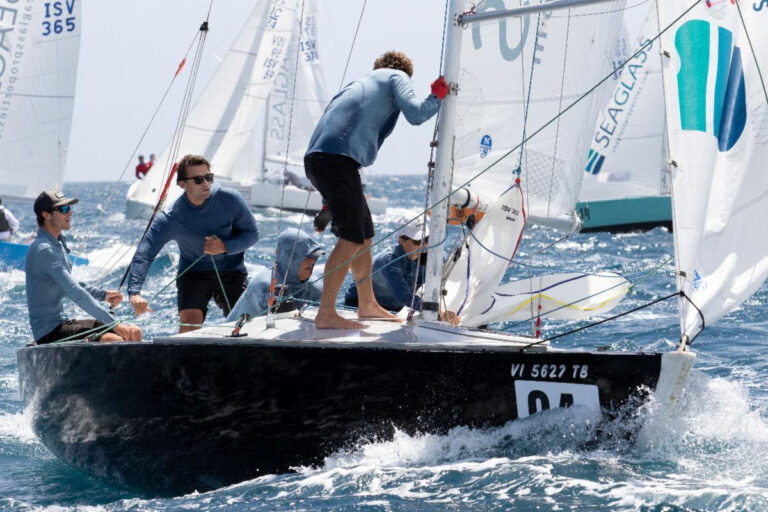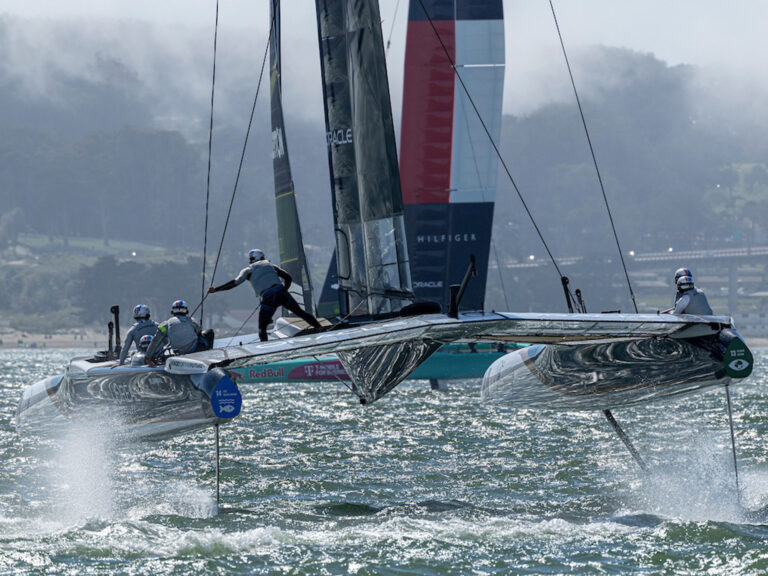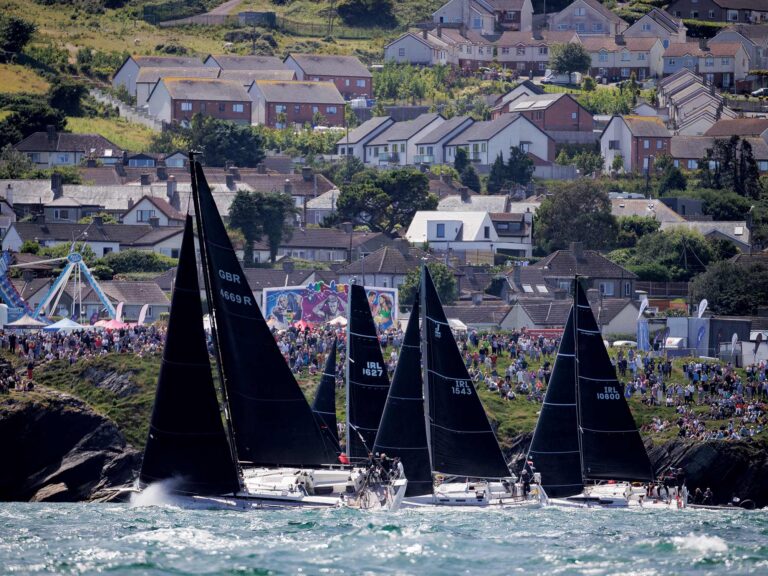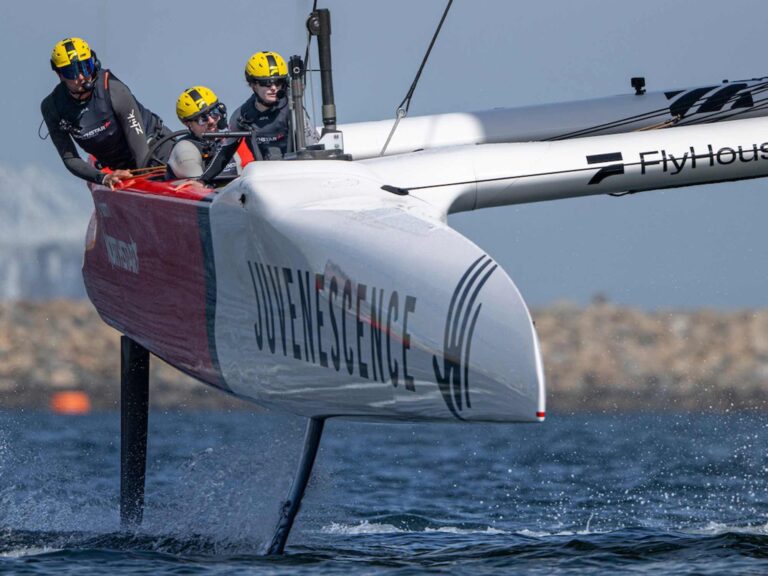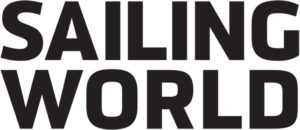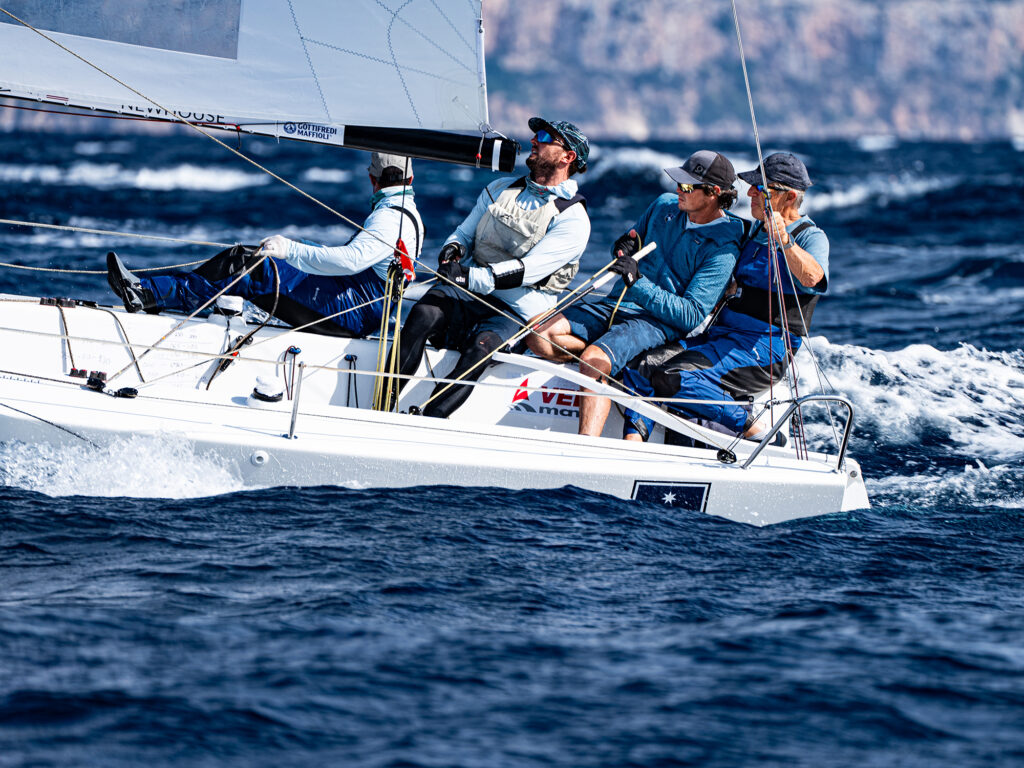
Doug Newhouse and his boat partner, Jeremy Wilmot, the 30-something Aussie-American pro sailor, won the J/70 World Championship title in Palma de Mallorca, Spain, this past September, in an effort that provides a compelling blueprint for any team with big-regatta aspirations. We sat down for an in-depth debrief in the library of the International Yacht Restoration School in Newport, Rhode Island, with a view over waters where Team Yonder trained and sail-tested for many days and more hours than Newhouse cares to remember, all of which led to a highly honed team and fast sails that propelled them to the top of the 98-boat fleet.
Where to begin…Doug?
Newhouse: The successes that I’ve had in my sailing career have all started with the crew, and I will say we had the best crew in the country, if not the world, with Jeremy, Ted Hackney and George Peet. When we started talking about going to Palma for the Worlds, I asked right away, “What is it going to take to have a shot at winning, and not just showing up as a participant?”
That meant ramping up the number of regattas that we were doing. It meant going to Europe and sailing. It meant coaching, doing summer training days with other top teams, and it meant more of a focus on all the different details and all the elements that had to be put together to actually go and win a major regatta like this. It meant having all of us consistently work together as a group. It meant having a focus and a specific goal.
And your coach, Evan Aras, had a hand in this win too.
Newhouse: We would not have won without Evan. He’s incredibly analytical, and I’m very analytical, so we can relate. He’s not a “rah, rah, guys, you’ve got this,” kind of coach. There’s none of that. It’s all fact-based. He has trained so many Olympians in Palma, so he knew the bay and the conditions there, which made an enormous impact. He knew, based on thousands of other people’s performances in Palma, where you want to be for certain weather conditions. We had three days of southerlies and five days of northerlies, and because of his knowledge of the venue, we understood exactly what was going on with the breeze and how that would impact pressure on the racecourse. He’s very cutting edge and very, very good.
Doug, as the elder and only amateur on a boat full of hot-shot pro sailors, what’s your takeaway from the experience?
Newhouse: One thing that always impresses me is the communication on board; it’s so honed. There’s no extraneous chatter. It’s all highly relevant and designed around getting one more place over another boat. If you do enough racing, you realize that over a five-day event, one or two boats in every race can make all the difference. It’s easy to say, “Well, sixth place is pretty good in a fleet of 95 boats.” But what if you get fourth? That’s better. And that’s what it’s like sailing with these guys—they never let up. We’d always be trying to gain another place.
There was an incredible singularity of focus that we had during the event. For example, measurement day is usually a day off from sailing so, in Palma, we went to play golf. We were scheduled to play 18 holes, but when I learned that the boat could go back into the water and we could actually go out sailing, I cut it to nine holes. I wasn’t happy with how our starting drills had been going and felt that we needed to start more, so we went back out.
Wilmot: We’re lucky to have Laura Grondin’s Dark Energy as our training partner, and we always line up with each other at regattas. When the race committee was having technical issues on the practice race day, we just went off and did moding practice with them—working on our high, low and fast modes. That was the best 90 minutes we had in the lead-up to the Worlds because we learned so much with them in that one session, and it all applied to the first day.
What makes a good lineup?
Wilmot: The common mistake that I see with a lot of other teams is they just go straight line testing, and they’ll start with one boat in a strong position or end the test when one boat is compromised. I prefer to line up as if we’re in a tough spot, like coming off the start and having to hold a high lane, because how are you ever going to find your high mode unless it’s absolutely forced upon you? So, I suggest to everyone, if you’re losing a lineup, don’t just reset. Just wait, because it’s a great opportunity to see if you can last in that mode or bad lane for 20 seconds. If you can extend that to 45 seconds during a race, there will be more options for you.
“Moding” is such a buzz phrase these days. What does that mean in a J/70?
Wilmot: In Palma, moding was our greatest strength because it was so shifty. It’s not that we were faster than everyone else in a straight line, because we weren’t, but we were a lot better than everyone else at switching modes. For example, if we needed to go to a high mode, we could do it straight away. Or if we needed to go to a fast mode, we could switch to it straight away. I can think of at least five lanes that saved our regatta, where we had to go fast mode or we had to go high mode, and that was our race. It comes down to how we warm up before the start: We find our modes, and if the conditions change between races, we go upwind and find them again.
I believe that the jib really sets the mode and what you’re trying to achieve, and especially on a J/70, where you can manipulate the clew position so much. With the inhauler and the sheet tension and the car position, you can change it so much. With just the smallest ease in the inhauler or the sheet, your power and your grip from the leech and the power down in the foot of the jib can change so dramatically. So, we start with the jib and work back from there to the mainsail.
What Doug was talking about with our communication, it got to the point where we didn’t need to say that we needed more grip, or that we needed more power, or to go to fast mode. Everyone was just so in tune with the situation, and I would just say, “Mode change,” and bang, everything moves. People get so caught up with hiking that they don’t want to switch gears because you’re taking weight off the rail. But the gear is the lane, and it’s how quickly you can switch those gears. Our approach to Palma was to do the most gear changes and more mode changes than any other boat out there. And we’re just going to do them faster.
You went out and won the first race and followed that with two sevenths. That’s impressive.
Wilmot: It was just one of those days where we never got forced off a shift by another boat, and we sailed to where we wanted to go. An interesting thing, though, was that we didn’t actually pass boats on the first two days. We actually lost boats on the first two days.
What we realized was that we were playing the shifts and being aggressive on the upwind legs, taking leverage on the pack when we thought it was appropriate, but on the downwinds, we were kind of just going wing-on-wing, and everyone was coming into us. We realized that we needed to be more aggressive with mode changes downwind.
I always try to sail downwind with the mentality that it’s where you can pass the most boats. So, I would say on the first two days, we were pretty bad downwind, and the last two were probably the best. We completely changed our mindset and found a way to switch modes faster than everyone else and attack the boats in front of us rather than just going to the wing, which was limiting us to what we could do.
We definitely got stuck in the mentality of just going 7 knots straight at the mark. On the short courses we normally sail at home, it’s doable—you just point out the mark because you’re not going to lose that much. The person who goes planing off to the side is going to need a pretty significant shift. But when the legs are 2 miles long, you’re almost sailing into a different weather system when you go planing off the side. You get different clouds, one side of the course is hot, the other side is cold.
The third day came with a bit of a slump—a 23 and a 17. What happened there?
Wilmot: Instead of focusing on getting better as the regatta went on, we went into that day thinking that what we’re doing was working, and we just got exposed. We took risks where we wouldn’t normally take risks. We just kept taking a little bit more leverage and a little bit more leverage, and that resulted in our 23rd. We also didn’t adjust our approach on the starting line in that we didn’t push for the favor end and we got lazy with our shifts. You know, we started looking for that big shift. Instead of taking a 5-degree shift that would take us across the course and link up with that next gust, we were like, “We’re only down 5.” Well, 5 degrees with 98 boats can be a lot. We lost a huge lead that day.
I imagine that required a bit of reset, which then got you back on track with a 10th and a second in the next two races.
Wilmot: We did get a bit of an ass kicking on the mental side of it. We could have just let the regatta run its course, or go out and do something about it. We’re definitely believers in there being no one big thing to change, but we’re open to changing 10 small things, and that’s what we did. We changed our lower-to-cap (shroud) ratio on the rig a tiny bit, we changed our jib car positions slightly, and we changed how we were trimming the jib a little bit—went away from vang sheeting and playing the traveler too much. On the third day, we were sailing the boat flatter than everyone, and the next day, we were more heeled than everyone. We went from like 12 to 14 degrees of heel to like 18 to 20.
You go into the final day—which was ultimately a one-race situation—with a 15-point lead and somehow stage an incredible comeback in the last race to finish 11th and win the whole thing. How’d you pull that off?
Wilmot: We did our normal thing where we start just up from the group and be confident about our acceleration. There was a 15- to 20-degree lefty, and it was like an auto attack for the entire fleet. I look over my shoulder, and the two boats we need to beat are 1-2 and we’re at least 40th. We sailed our worst leg of the regatta that first leg, but the last three legs were our best. I went back and looked at the race statistics, and I’m pretty sure we were the fastest on that first downwind, and gained the most distance on the leaders. And then we did it on the next upwind and took 45 seconds off the leaders, and then by the finish, we took another 30.
People get so caught up with hiking that they don’t want to switch gears because you’re taking weight off the rail. But the gear is the lane, and it’s how quickly you can switch those gears. Our approach was to do the most gear changes than any other boat out there. And we’re just going to do them faster.
For an owner looking to build a J/70 team from scratch, what are key skillsets to get right?
Wilmot: The front position is unique on a J/70 because you’ve got a person who’s sitting straight upright, and they’re looking straight at the wind, so if you don’t have someone up there who has a tactical and strategic mentality, you’re really wasting that position. The trimmer has the hardest job because they’re doing everything, and the crossovers for all those modes are tiny. The trimmers in this fleet are unbelievable, and the ones who can do it really well are in a league of their own. So, if you’re filling that position, you should be looking at the best sailor you can find and give them time to get used to the J/70.
Newhouse: A number of owners have told me that they are both impressed with and jealous of our team chemistry. We do get along extremely well, and there is no fighting on the team. Everybody knows what they’re supposed to be doing at any given point in time. It’s having a team that’s in a groove. We had a great group for this regatta, and it all came together for us, but I think the chemistry thing is so important. I accept the fact that I brought on board the absolute best people I could possibly find. I do this in businesses all the time. I rely implicitly on having the talent to drive results, and I know that we had the best talent in Palma.
